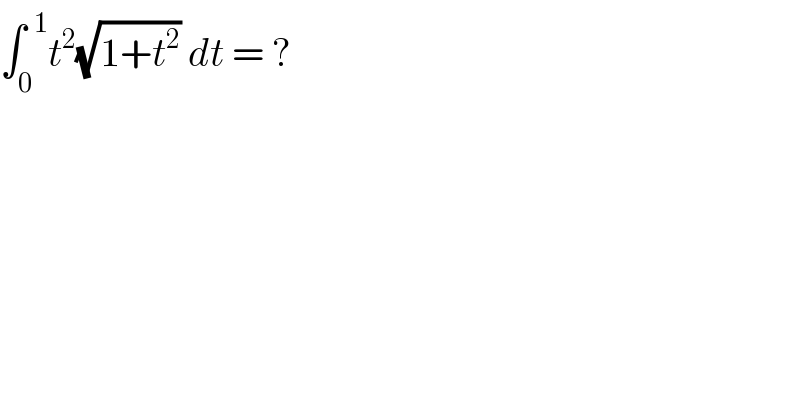
Question and Answers Forum
Question Number 35379 by lilesh7 last updated on 18/May/18

Commented by prof Abdo imad last updated on 18/May/18
![let put I = ∫_0 ^1 t^2 (√(1+t^2 )) dt.changement t=shx give I = ∫_0 ^(ln(1+(√(2)))) sh^2 x chx.chxdx =∫_0 ^(ln(1+(√2))) (shx chx)^2 dx =(1/4) ∫_0 ^(ln(1+(√2))) sh^2 (2x)dx =(1/4) ∫_0 ^(ln(1+(√2))) ((ch(4x)−1)/2)dx =(1/8) ∫_0 ^(ln(1+(√2))) ch(4x)dx −(1/8)ln(1+(√2)) = (1/(32))[ sh(4x)]_0 ^(ln(1+(√2))) −(1/8)ln(1+(√2)) =(1/(32)) sh(4ln(1+(√(2)))) −(1/8)ln(1+(√2)) but we have shx =((e^x −e^(−x) )/2) ⇒sh(4ln(1+(√(2)))) =((e^(4ln(1+(√2))) − e^(−4ln(1+(√2))) )/2)=(((1+(√2))^4 −(1/((1+(√2))^4 )))/2)⇒ I = (1/(64)){ (1+(√2))^4 −(1+(√2))^(−4) } −(1/8)ln(1+(√2)) let remember that argsh(x)=ln(x+(√(x^2 +1))) argchx=ln(x +(√(x^2 −1)))](Q35398.png)
Commented by ajfour last updated on 18/May/18

Commented by abdo mathsup 649 cc last updated on 18/May/18

Answered by MJS last updated on 18/May/18
![∫t^2 (√(t^2 +1))dt=∫(t^2 +1−1)(√(t^2 +1))dt= =∫((t^2 +1)(√(t^2 +1))−(√(t^2 +1)))dt= =∫(t^2 +1)^(3/2) dt−∫(t^2 +1)^(1/2) dt= [t=tan(u) → dt=sec^2 (u)du] =∫sec^2 (u)(tan^2 (u)+1)^(3/2) du−∫sec^2 (u)(tan^2 (u)+1)^(1/2) du= [tan^2 (u)+1=sec^2 (u)] =∫sec^5 (u)du−∫sec^3 (u)du now use the reduction formula ∫sec^n (α)dα=((sec^(n−2) (α)tan(α))/(n−1))+((n−2)/(n−1))∫sec^(n−2) (α)dα](Q35386.png)
Answered by sma3l2996 last updated on 18/May/18
![I=∫_0 ^1 t^2 (√(1+t^2 ))dt=∫_0 ^1 t×t(√(1+t^2 ))dt by parts u=t⇒u′=1 v′=t(√(1+t^2 ))⇒v=(1/3)(1+t^2 )(√(1+t^2 )) So I=(1/3)[t(1+t^2 )(√(1+t^2 ))]_0 ^1 −(1/3)∫_0 ^1 (1+t^2 )(√(1+t^2 ))dt I=((2(√2))/3)−(1/3)∫_0 ^1 ((√(1+t^2 ))+t^2 (√(1+t^2 )))dt=((2(√2))/3)−(1/3)∫_0 ^1 (√(1+t^2 ))dt−(1/3)I (4/3)I=((2(√2))/3)−(1/3)∫_0 ^1 (√(1+t^2 ))dt let t=sinh(u)⇒dt=cosh(u)du (√(1+t^2 ))=(√(1+sinh^2 u))=cosh(u) So ∫_0 ^1 (√(1+t^2 ))dt=∫_0 ^(sinh^(−1) (1)) cosh^2 (u)du=(1/2)∫_0 ^(sinh^(−1) (1)) (1+cosh(2u))du =(1/2)[u+(1/2)sinh(2u)]_0 ^(sinh^(−1) (1)) =(1/2)(sinh^(−1) (1)+(√2)) =(1/2)(ln(1+(√2))+(√2)) So I=((√2)/2)−(1/4)((1/2)ln(1+(√2))+((√2)/2)) I=((7(√2))/8)−(1/8)ln(1+(√2))](Q35392.png)
